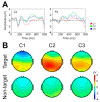Effect of Distracting Background Speech in an Auditory Brain-Computer Interface
- PMID: 33401410
- PMCID: PMC7823829
- DOI: 10.3390/brainsci11010039
Effect of Distracting Background Speech in an Auditory Brain-Computer Interface
Abstract
Studies so far have analyzed the effect of distractor stimuli in different types of brain-computer interface (BCI). However, the effect of a background speech has not been studied using an auditory event-related potential (ERP-BCI), a convenient option when the visual path cannot be adopted by users. Thus, the aim of the present work is to examine the impact of a background speech on selection performance and user workload in auditory BCI systems. Eleven participants tested three conditions: (i) auditory BCI control condition, (ii) auditory BCI with a background speech to ignore (non-attentional condition), and (iii) auditory BCI while the user has to pay attention to the background speech (attentional condition). The results demonstrated that, despite no significant differences in performance, shared attention to auditory BCI and background speech required a higher cognitive workload. In addition, the P300 target stimuli in the non-attentional condition were significantly higher than those in the attentional condition for several channels. The non-attentional condition was the only condition that showed significant differences in the amplitude of the P300 between target and non-target stimuli. The present study indicates that background speech, especially when it is attended to, is an important interference that should be avoided while using an auditory BCI.
Keywords: auditory; brain–computer interface (BCI); distractor; event-related potential (ERP); workload.
Conflict of interest statement
The authors declare no conflict of interest. The funders had no role in the design of the study; in the collection, analyses, or interpretation of data; in the writing of the manuscript, or in the decision to publish the results.
Figures






References
-
- Ramsey N.F., Van De Heuvel M.P., Kho K.H., Leijten F.S.S. Towards human BCI applications based on cognitive brain systems: An investigation of neural signals recorded from the dorsolateral prefrontal cortex. IEEE Trans. Neural Syst. Rehabil. Eng. 2006;14:214–217. doi: 10.1109/TNSRE.2006.875582. - DOI - PubMed
Grants and funding
LinkOut - more resources
Full Text Sources
Other Literature Sources
Miscellaneous

